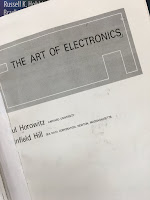 |
| The Art of Electronics, by Horowitz and Hill. |
Electronics, perhaps more than any other field of technology, has enjoyed an explosive development in the last four decades. Thus it was with some trepidation that we attempted, in 1980, to bring out a definitive volume teaching the art of the subject. By “art” we meant the kind of mastery that comes from an intimate familiarity with real circuits, actual devices, and the like, rather than the more abstract approach often favored in textbooks on electronics.The Art of Electronics is particularly useful for understanding active circuits, such as those including transistors and operational amplifiers. I recall that in graduate school my education had a conspicuous hole in that I didn’t understand transistors, and The Art of Electronics helped me learn about them in an intuitive way (I still recall fondly Horowitz and Hill’s “transistor man”).
Russ Hobbie and I don’t discuss electronics explicitly in the fourth edition of Intermediate Physics for Medicine and Biology, but it is implicit in some chapters. For instance, thin film transistor arrays are discussed briefly in Chapter 16, used for detecting x-ray images. In Chapter 6, Figure 6.32 shows the apparatus for making voltage-clamp measurements. The “controller” in that figure is basically an op-amp, and in order to understand how it works one needs to appreciate their “golden rules”: 1) the output does whatever is necessary to make the voltage difference between the inputs zero, and 2) the inputs draw no current. You can do a lot with an op amp, including simple circuits such as a voltage follower (which is needed if you want to record a voltage using a large input impedance, something that is important in bioelectric recordings), simple amplifiers, integrators and differentiators. Horowitz and Hill describe all these circuits and more, in a way that can be understood by the beginner. For me, The Art of Electronics is to electronic circuits what Numerical Recipes is to computational methods: a well-written book that lets you learn the essence of the subject and the practical applications, without getting bogged down in all the esoteric details.
My timer for our microelectrode puller worked, although it wasn’t pretty. As I recall, it was built using leftover parts, and looked something like a big toaster with gigantic, 1950s-style knobs. But it allowed me to pull glass microelectrodes with a reproducible resistance to use in intracellular measurements of voltage in nerve axons. My experimental work culminated in the first simultaneous measurement of the transmembrane potential and magnetic field of a nerve axon (see Barach, Roth, and Wikswo, IEEE Trans. Biomed. Eng., Volume 32, Pages 136–140, 1985; and Roth and Wikswo, Biophys. J., Volume 48, Pages 93–109, 1985). The Biophysical Journal paper is one of my favorites, and represents the high water mark of my experimental career. However, I also like the less-cited IEEE TBME paper for two reasons: it was my very first journal article (appearing in February of 1985, whereas the Biophysical Journal paper appeared in July), and it is my only paper in which I supplied the experimental data and someone else (in this case, Prof. John Barach) performed the theoretical analysis. However, it soon became apparent that my talents and interests were more in mathematical modeling and computer simulation. Nevertheless, I have always had enormous respect for experimental work, which in my view is more difficult than theoretical analysis. I have suffered from a case of “experimentalist envy” since those formative years in graduate school.
Rumor has it that a 3rd edition of The Art of Electronics will appear soon.



When I used Horowitz, our professor always said "it's a great book once you know some electronics." I'll have to do a reread. Cheers to the experimentalists!
ReplyDelete